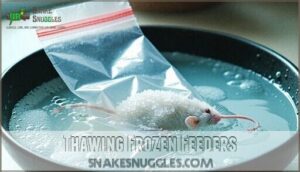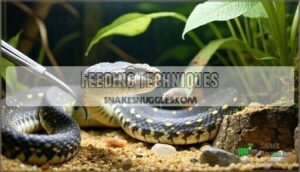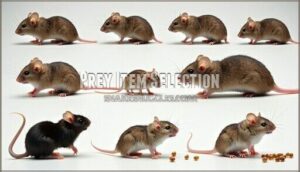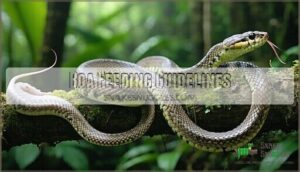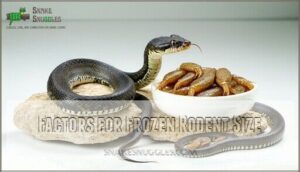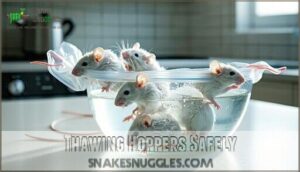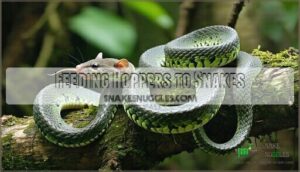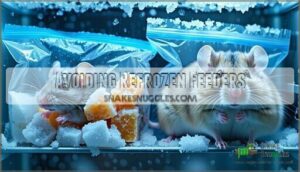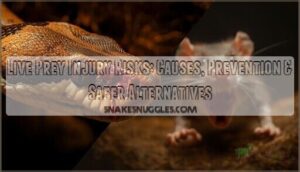This site is supported by our readers. We may earn a commission, at no cost to you, if you purchase through links.
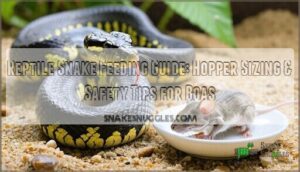
You’ll want prey that’s roughly 10-15% of your snake’s body weight. Thaw frozen hoppers completely in warm water, never the microwave, which creates dangerous hot spots.
Watch for the telltale bulge after feeding—it should be noticeable but not excessive. Pre-killed frozen prey eliminates bite risks while maintaining nutritional value.
Your boa’s feeding response and body condition tell the real story of whether you’re hitting the sweet spot with size and frequency.
Table Of Contents
- Key Takeaways
- Snake Feeding Basics
- Frozen Feeders Guide
- Boa Constrictor Health
- Boa Feeding Guidelines
- Reptile Diet Types
- Hopper Feeding Tips
- Frequently Asked Questions (FAQs)
- What are hoppers for snakes?
- What is the feeding pattern for snakes?
- How to force feed a snake that won’t eat?
- How often should juvenile snakes eat hoppers?
- Can snakes eat hoppers that smell funny?
- What hopper size for pregnant female snakes?
- Should hoppers be fed live or frozen?
- How long can hoppers stay uneaten?
- Conclusion
Key Takeaways
- Match hopper size to your snake’s girth – You’ll need prey that’s 10-15% of your boa’s body weight and matches 1.0x to 1.5x their thickest body section to prevent regurgitation and digestive issues.
- Thaw frozen hoppers safely in warm water – You should never use a microwave since it creates dangerous hot spots and destroys nutrients; instead, submerge sealed hoppers in warm water for 15 minutes until they’re room temperature throughout.
- Feed juveniles every 6-7 days, adults less frequently – You’ll feed juvenile boas (51-90g) hoppers weekly, but adult snakes need meals only every 30-37 days based on their slower metabolism and seasonal patterns.
- Remove uneaten hoppers within 30 minutes – You can’t safely leave thawed prey longer since bacterial growth develops rapidly, and you should never refreeze leftover feeders due to toxin buildup risks.
Snake Feeding Basics
You’ll need to understand your snake’s current feeding routine before making any changes, since switching prey types or sizes too quickly can cause serious digestive problems.
Getting the basics right—from proper feeder sizing to preventing regurgitation—forms the foundation for keeping your snake healthy and well-fed throughout its life.
Current Diet Assessment
Before you bring your new snake home, get the full scoop on its current reptile diet guide from the breeder. This breeder information acts as your roadmap for a smooth handover.
Some snakes become finicky eaters when switching from their familiar menu.
- Ask specifically about prey size, feeding frequency, and preferred food types
- Document any special feeding techniques or mimicking smells used successfully
- Request details about the snake’s eating patterns and behavioral cues during meals
Starting with familiar food prevents feeding strikes and helps your snake settle into its new home without stress.
Switching Prey Items
When switching prey items, start with mimicking smells from your snake’s current diet on new feeders.
Gradual introduction prevents refusal – avoid jumping from high-fat prey like guinea pigs to lean options immediately.
If your snake refuses domestic rodents consistently, professional consultation becomes essential.
Live prey’s benefits include stimulating natural hunting instincts.
Monitor feeder adjustment carefully, as stubborn eaters may need specialized prey switching techniques for successful feeder selection changes.
Feeder Size Guidelines
Proper feeder sizing directly impacts your snake’s health and prevents serious complications.
Your prey should measure 1.0x to 1.5x your snake’s thickest body section – never exceed this ratio.
Hopper mouse size typically works for juvenile pythons, while frozen feeders offer consistent sizing options.
Overfeeding risks include regurgitation dangers and digestive stress.
When selecting feeder size, meal proportion matters more than frequency.
Body thickness measurements guide your choices better than weight alone, considering the importance of proper feeder sizing.
Regurgitation Prevention
Regurgitation happens when your snake can’t properly digest oversized prekilled prey, creating serious health risks.
Oversized prey turns your snake’s stomach into a time bomb waiting to explode.
Maintain stable temperature zones throughout your enclosure – cold spots disrupt snake digestion completely. Start with smaller feeders after any feeding break, then implement gradual increase over several meals.
Quality feeder thawing prevents digestive shock, while proper handling reduces stress that triggers regurgitation. Wait 7-10 days between feeding attempts if regurgitation occurs, and ensure to follow the guidelines for a proper handling.
Frozen Feeders Guide
Frozen feeders offer a safer feeding option for your snake compared to live prey.
You’ll need to properly thaw and present these frozen rodents to guarantee your snake accepts them and digests them safely.
Thawing Frozen Feeders
Never microwave frozen feeders – it destroys nutritional value and promotes dangerous bacteria growth.
Instead, place your prekilled prey in a sealed bag and submerge in warm water for fifteen minutes.
The feeder should feel squishy and room temperature throughout, not cold. This warm water thawing method preserves nutrients while ensuring safe feeder temperature for proper digestion.
For ideal safety, remember to follow safe thawing practices carefully, using proper techniques to avoid contamination.
Feeding Techniques
Through trial and error, you’ll master safe snake feeding techniques that keep both you and your serpent healthy.
Here are five essential feeding methods every snake owner should follow:
- Use rubber-tipped tongs – Never feed with your hands to avoid accidental bites during feeding time
- Swing the hopper gently – This mimicking prey movement triggers your snake’s natural hunting instincts
- Maintain proper temperatures – Keep your enclosure at ideal heat levels before offering any meal
- Establish a consistent feeding schedule – Regular routine adjustments help reduce feeding stress and refusal
- Choose live vs. frozen wisely – Frozen feeders reduce disease risk while live prey can injure captive-bred snakes
Prey Item Selection
Now that you’ve mastered feeding techniques, choosing the right prey items becomes your next strategic move.
Your snake’s health depends on selecting appropriate feeders that match their natural dietary needs and body size requirements.
| Live vs. Frozen | Nutritional Balance | Gut Loading |
|---|---|---|
| Frozen reduces injury risk | Rats offer more protein | Feed crickets 24 hours |
| Live stimulates hunting | Mice provide higher fat | Use quality gut-load diet |
| Frozen prevents parasites | Variety prevents deficiency | Enhances prey nutrition |
Consider prey variety beyond standard mice and rats.
To guarantee proper nutrition, consider that rats are more nutritious than mice in the long term.
Quail, chicks, and appropriately sized hoppers can encourage picky feeders while providing nutritional diversity.
Always source from ethical suppliers who maintain proper breeding conditions and health standards for their feeder animals.
Boa Constrictor Health
You’ll recognize a healthy boa by its square body shape with a slight groove running down the center of its back.
Monitoring your boa’s weight and body condition helps prevent serious health issues like fatty liver disease or malnutrition-related complications, which can be critical to address for the boa’s overall health.
Healthy Boa Characteristics
A healthy boa constrictor shows a square body shape with a slight groove down the back’s center.
You’ll notice normal skin wrinkles without excessive fat deposits or visible spine protrusion. Good muscle tone creates this characteristic appearance.
Weight tracking helps monitor your snake’s health through regular observation. Proper spinal health means no protruding vertebrae.
This snake feeding guide emphasizes recognizing these healthy characteristics in your boa constrictor before adjusting hopper sizes or feeding schedules, ensuring proper spinal health and maintaining a healthy boa constrictor.
Overweight Boa Constrictor
Watch for telltale signs of excess weight in your boa constrictor through careful wrinkle assessment.
Overweight boas develop excessive skin wrinkling and distinctive ring-shaped deposits around their bodies, creating visible fat rolls that indicate serious overfeeding risks.
This condition can progress to Fatty Liver Disease, a potentially fatal health issue.
Additionally, overweight boas show decreased activity levels and sluggish behavior, making proper feeding guidelines essential for maintaining peak health and preventing overfeeding risks.
Underweight Boa Constrictor
If your boa looks skinnier than usual, you’ve spotted a problem that needs quick action.
Identifying underweight boas means checking for triangular body shape, visible spine, and reduced muscle tone.
Poor snake feeding habits, illness, or inadequate temperatures often cause weight loss in reptiles.
- Triangle body shape – Healthy boas maintain square profiles, not angular ones
- Visible spine ridge – The backbone shouldn’t stick out along your snake’s back
- Loose, wrinkled skin – Skin should fit snugly without excess folding
- Reduced muscle tone – Muscles should feel firm when gently handled
- Poor feeding response – Underweight snakes often show less interest in food
Boa Feeding Guidelines
Understanding your boa’s feeding requirements prevents common health issues and promotes proper growth throughout their lifespan.
You’ll need to adjust prey size, feeding frequency, and seasonal patterns based on your snake’s age and body condition to ensure proper growth.
Prey Size Recommendations
Choose prey matching your snake’s ideal girth—never exceeding 1.25 times the widest body section.
This hopper mouse sizing prevents overfeeding while minimizing regurgitation risks.
Adults handle slightly larger frozen rodents than juveniles, but consistent size progression matters most.
Your snake feeding guide should prioritize feeder weight matching body thickness over ambitious hopper feeding schedule jumps.
Feeding Frequency
Feeding frequency impacts your boa’s health through age-based schedules and metabolic rates.
Temperature shifts directly influence how often you’ll offer meals, making feeding logs essential for tracking patterns.
Age-Based Feeding Schedule:
- Juveniles (1-2 years) – Every 7-10 days during active periods
- Subadults (3-4 years) – Every 10-14 days with seasonal adjustments
- Adults (5+ years) – Every 30-37 days following natural reptile feeding habits
Seasonal Eating Patterns
Unlike feeding frequency which stays consistent year-round, your boa’s seasonal eating patterns will naturally shift with temperature changes.
During winter fasting periods, metabolic changes reduce appetite by 30%, triggering brumation feeding cycles.
Don’t panic when breeding cycles or temperature impact causes reduced intake – it’s normal snake feeding habits.
Respect these seasonal eating patterns rather than forcing your regular feeding schedule, and recognize that reduced intake is a natural part of winter fasting periods.
Reptile Diet Types
You’ll want to understand the nutritional differences between common feeder insects before choosing what to offer your boa.
Each feeder type provides unique protein, fat, and mineral profiles that can impact your snake’s health and digestion when used as part of a varied diet, considering the importance of a balanced diet.
Nutritional Considerations
Nutritional diversity acts as your snake’s health insurance policy.
You’ll need dietary balance with proper calcium-to-phosphorus ratios, essential proteins, and vitamins from varied feeders.
Gut loading prey boosts nutritional value substantially, and different feeder types stimulate natural foraging behavior while preventing picky eating habits.
This variety enhances color development and supports ideal snake nutrition through detailed feeder nutrition profiles, ensuring overall nutritional diversity.
Dubia Roaches Benefits
Dubia roaches reign supreme as the gold standard protein source for reptile snake feeding. These powerhouse prey items pack 20-25% protein content, outperforming traditional options while offering superior gut loading capabilities.
Looking at the paragraph about Dubia roaches and the engaging, informative tone of the content, here’s a short blockquote:
Dubia roaches deliver unmatched protein power for your snake’s optimal health.
They’re also considered a reliable feeder insect due to their nutritional benefits.
- Extended roaches lifespan means fresher feeders with consistent nutritional value
- Lower chitin benefits promote easier digestion than crickets or mealworms
- Balanced nutrition delivers ideal calcium-to-phosphorus ratios for bone health
- Versatile snake food types accommodate various species from ball pythons to boas
Cricket Nutrition
Crickets pack a nutritional punch for your reptile snake feeding routine. These hoppers contain 17-25% protein and essential amino acids your snake needs. However, cricket calcium levels run low compared to phosphorus, creating an imbalanced ratio.
| Nutrient | Cricket Content |
|---|---|
| Protein | 17-25% by weight |
| Moisture | 70-75% content |
| Iron | 9.5mg per 100g |
Gut loading crickets 24-48 hours before feeding boosts their cricket vitamins and mineral content. Feed them leafy greens, carrots, or commercial gut-loading diets. To confirm proper nutrient absorption, consider reptile dietary needs.
This hydration methods approach transforms ordinary crickets into nutritional powerhouses, improving your snake’s fiber content intake and overall health.
Mealworm Nutrition
Mealworm composition offers protein levels reaching 23% dry weight, making them excellent supplemental feeders for your snake diet.
However, their calcium content remains remarkably low with a problematic Ca:P ratio of 0.07:1.
Gut loading these feeders before offering them substantially improves their nutritional value. Their chitin benefits include supporting digestive health, though excessive fat content requires careful portion control.
Proper storage methods maintain freshness and prevent spoilage in your reptile feeding routine.
Hopper Feeding Tips
Feeding hoppers to your snake requires careful attention to size and temperature to prevent digestive issues and regurgitation.
You’ll need to thaw frozen hoppers properly and never refreeze leftover prey to avoid bacterial contamination that could harm your reptile.
Factors for Frozen Rodent Size
Selecting the right frozen reptile food depends on your snake’s measurements and growth stage. Snake body size determines prey girth ratio – measure your boa’s thickest section to match appropriate feeders.
Consider these key factors for ideal frozen rodent sizing:
- Body measurement – Match prey width to 1-1.5x your snake’s thickest diameter
- Age and weight – Juveniles need hoppers, adults require larger rats
- Seasonal feeding needs – Winter metabolism slows, allowing smaller prey
- Individual appetite – Monitor hunting behavior and body condition
- Regurgitation risk – Oversized feeders stress digestion, especially in new snakes
Your reptile feeding chart should track these variables. Live vs frozen doesn’t affect sizing rules, but frozen offers better control over prey dimensions and reduces injury risk.
Thawing Hoppers Safely
Instead of microwaving frozen reptile food, always use warm water thawing for safe feeder preparation.
Place hoppers in a sealed bag, then submerge in hand-comfortable water for fifteen minutes.
This method prevents microwave dangers that destroy nutrition and promote bacteria.
Many owners find reptile thawing products useful for this process.
Check hopper temperature—it should feel squishy, not cold.
Never refreeze thawed feeders due to serious refreezing hazards.
Feeding Hoppers to Snakes
Use proper hopper size for your snake’s girth when feeding.
Hold the thawed hopper with rubber-tipped tongs and swing it gently to trigger your snake’s feeding response. This hopper introduction mimics natural prey movement.
Consider the appropriate hopper dimensions for your snake’s age and size.
Remove any uneaten hoppers within thirty minutes to prevent bacterial growth. Proper hopper gutload guarantees maximal nutritional value for healthy snake feeding.
Avoiding Refrozen Feeders
Never refreeze thawed feeders once they’ve warmed up, as this practice creates dangerous bacterial growth and nutritional loss.
Refrozen rodents develop toxin buildup that poses serious health risks to your snake. Fresh frozen rodents maintain superior feeder quality and safety standards.
- Bacterial Growth: Thawed feeders develop harmful bacteria within hours that multiplies rapidly when refrozen
- Nutritional Loss: Repeated freeze-thaw cycles break down proteins and vitamins, reducing feeder quality substantially
- Food Safety: Single-use thawing prevents toxin buildup and maintains proper snake feeding safety protocols
To guarantee safety, follow safe thawing methods.
Frequently Asked Questions (FAQs)
What are hoppers for snakes?
Hoppers are juvenile rabbits, typically 3-4 months old and weighing 2-4 pounds.
They’re the next size up from adult rats in the prey progression, and you’ll use them to feed larger snake species like adult boas and pythons.
What is the feeding pattern for snakes?
Like clockwork in nature, you’ll feed your snake based on age and season.
Juveniles eat every 5-10 days, while adults need meals every 30-90 days depending on temperature cycles and metabolism.
How to force feed a snake that won’t eat?
Force-feeding snakes isn’t recommended and can cause serious injury or stress.
Instead, check your enclosure temperatures, try thawing prey properly in warm water.
Consult a reptile veterinarian if feeding issues persist beyond normal fasting periods, and ensure to handle the situation with proper care.
How often should juvenile snakes eat hoppers?
Feed juvenile snakes hoppers every 7-10 days during warmer months, extending to every 14-21 days in winter.
You’ll adjust frequency based on your snake’s metabolism, temperature, and body condition for ideal growth.
Can snakes eat hoppers that smell funny?
Never feed your snake hoppers with off-putting odors. Strange smells indicate spoilage or bacterial growth, which can cause serious digestive issues or illness. Always discard questionable feeders immediately.
What hopper size for pregnant female snakes?
Pregnant snakes need slightly smaller hoppers than usual—about 8x to 0x their thickest body section.
You’ll want to reduce meal size by 25% to prevent complications during gravidity and guarantee safe digestion.
Should hoppers be fed live or frozen?
Like choosing between a loaded gun and a safety net, frozen hoppers offer clear advantages.
You’ll find frozen feeders reduce disease risk and injury potential compared to live prey.
They’re safer for captive-bred snakes, which is a clear advantage when considering the well-being of the animals.
How long can hoppers stay uneaten?
Uneaten hoppers should be removed within 30 minutes to prevent spoilage and bacterial growth. You can’t safely leave them longer since they’ll develop harmful bacteria that could make your snake sick.
Conclusion
Smart snake stewards succeed through systematic sizing strategies. Your reptile snake feeding guide hopper knowledge now empowers you to feed confidently and safely.
Remember that proper prey sizing prevents regurgitation while thawed feeders eliminate injury risks.
Monitor your boa’s body condition regularly, adjusting portions as needed. Consistent feeding schedules paired with appropriate hopper sizes create healthy, thriving serpents.
Trust your observations and maintain these evidence-based practices for ideal results.
- http://mailto:hello
- https://www.ncbi.nlm.nih.gov/pmc/articles/PMC4005007/
- https://a-z-animals.com/blog/are-lizards-poisonous-and-3-types-of-venomous-lizards/
- https://www.encyclopedia.com/science-and-technology/biochemistry/biochemistry/chitin
- https://reptilesmagazine.com/the-vet-report-environmental-enrichment-for-reptiles/

